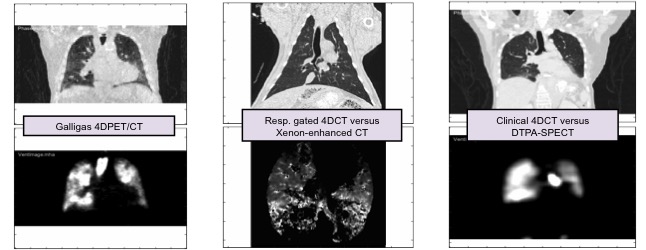Vampire Public Data Page
VAMPIRE Challenge
The VAMPIRE Challenge aimed to determine the most accurate CT ventilation imaging algorithms across a range of different imaging conditions. The VAMPIRE dataset currently consists of 50 pairs of 4DCT and ground truth ventilation scans (SPECT, PET or Xenon-CT) from 3 institutions.
Please contact the study leads (listed below) to request permission to access the data.

We are extremely thankful for the following researchers / institutions for providing their imaging data to this study:
- Dr Shankar Siva and Prof. Michael Hofman (Peter MacCallum Cancer Centre, Melbourne, VIC Australia): 25 pairs of Galligas ventilation scans using a combined 4D-PET/CT scanner. Supported in part by a Priority-Drive Collaborative Cancer Research Scheme 2013 grant (APP 1060919) and by scholarship funding from the National Health and Medical Research Council.
Siva et al, “Ventilation/Perfusion Positron Emission Tomography-Based Assessment of Radiation Injury to Lung,” International Journal of Radiation Oncology*Biology*Physics 93, 408-417 (2015). - Prof. Joseph Reinhardt and Prof. Gary Christensen (University of Iowa, Iowa City, IA USA): 4 pairs of prospectively-gated 4DCT and Xenon CT. Supported in part by grants HL079406, HL064368, and EB004126 from the National Institutes of Health.
Reinhardt et al., “Registration-based estimates of local lung tissue expansion compared to xenon CT measures of specific ventilation,” Medical image analysis 12, 752-763 (2008). - Dr Tokihiro Yamamoto (University of California-Davis, Davis, CA USA): 21 pairs of clinical 4DCT and DTPA ventilation SPECT scans originally acquired at Stanford University. Supported in part by a National Lung Cancer Partnership Young Investigator Research grant and National Institutes of Health / National Cancer Institute grant R01 CA 093626.
Yamamoto et al., “Pulmonary Ventilation Imaging Based on 4-Dimensional Computed Tomography: Comparison With Pulmonary Function Tests and SPECT Ventilation Images,” International Journal of Radiation Oncology*Biology*Physics 90, 414-422 (2014).

